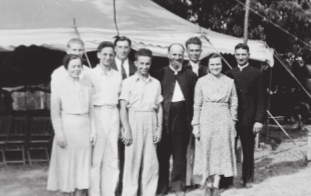Editor’s Note: Thanks to Devin Manzullo-Thomas for allowing me to adapt the author/editor interviews he did for his blog, “The Search for Piety and Obedience” (devincthomas.wordpress.com), for use here.
Worthy of the Calling is the next book to be published by the Historical Society in the series of biographies of people who have contributed significantly to the Brethren in Christ Church. Three couples are profiled in the book: Paul and Lela Hostetler, written by their daughter Beth Hostetler Mark; Luke and Doris Keefer, by Historical Society assistant editor Devin Manzullo-Thomas; and Harvey and Erma Sider, by Harvey’s sister AnnaRuth Sider Osborne. The book is edited by E. Morris Sider, editor emeritus for the Historical Society.
Why biographies of these three couples? Morris answers the question this way: “The biographees are representative of the Brethren in Christ in the last half of the twentieth century. The Hostetlers represent pastoral ministry; the Siders missions and administrative leadership; and the Keefers academic life and doctrinal issues. Also, they have not been subjects of the 150 or so biographies and autobiographies produced in the last several decades.”
Of her biography of her brother and sister-in-law, AnnaRuth notes that “Harvey and Erma are important to Brethren in Christ history for their leadership during a time when the church struggled to find its voice in a changing world.“ Beth characterizes her parents as “a typical, conservatively dressed, Brethren in Christ couple who began ministry (in 1949) on the cusp of a ‘denominational sea change.’ In other ways their pastoral ministry illustrates how early adoption of evangelical methods of outreach and contemporary clothing (by them and their peer congregants) helped their congregations become more welcoming of non-historically Brethren in Christ individuals. Their second pastorate is illustrative of an early, non-rural church planting, and my father’s later ministry with the Brethren in Christ Stewardship Office sheds light on the attempt to gain support for giving to Cooperative Ministries, rather than to individual Brethren in Christ board ministries.” Devin describes Luke as someone who in his roles as college professor, member of denominational boards and committees, pastor, evangelist, and author of works on Brethren in Christ theology and history “made lasting contributions to the life and thought of his beloved denomination.”
Each of the authors started their research and writing already respecting their subjects, but came to a new appreciation for them in the course of their work. Each also faced challenges. For example, AnnaRuth had to sift through fifty years’ worth of writing by Harvey and Erma, plus many interviews with colleagues and family members, to select and condense what would go in the final biography. She regrets having to leave out some wonderful stories for lack of space.
Noting that “researching is always my favorite part,” Beth says that “buckling down to writing is the most difficult!” Beth also recounts that when she started the project, her mother was in the last years of her life. So after collecting a lot of interviews (mostly by email), she decided to share them with her parents. These interviews helped them in the weeks before Lela passed away to “look back over a period of sixty years and see where God had clearly led them and how their ministry fit into the historical context of the denomination.”
Devin’s research blended the approaches of his fellow authors, joining conventional archival research with oral history interviews. Luke’s voluminous writings on Brethren in Christ history and theology provided much material to work with, as did his personal papers, which were posthumously deposited in the Brethren in Christ Historical Library and Archives. Meanwhile, he also conducted numerous interviews with friends, family, and colleagues of Luke and Doris. “It was a special honor to sit for many hours with Doris,” Devin notes. “I appreciated her willingness to share both the challenges and triumphs of her and Luke’s life together.”
Morris notes that readers of the biographies will be better able to understand the church in the years spanned by the lives of these three couples. In particular, he says, readers will learn about the sense of heritage that was a part of the church in those years, the importance of women in ministry, family life, changes that developed in church life and doctrine, the importance of Christian community, the significance of the Pietist and Anabaptist elements that run throughout those years, the church’s institutions and events, and sacrificial service.


